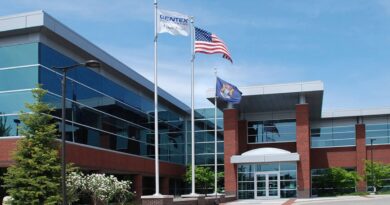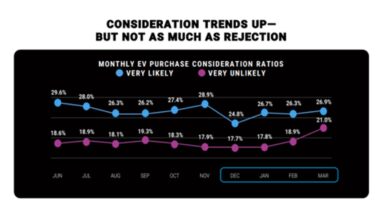Auto industry evolution inspires new direction at seating supplier Adient
The continued turbulence of the automotive industry and the rapid transition to electrification has driven seating supplier Adient plc to take a new approach to doing business.
It’s no longer about growing market share at all costs, or winning every contract no matter the value proposition, according to CEO Doug Del Grosso.
The Plymouth-based company, projected to hit $15 million in revenue this year, has become more deliberate about walking away from business it doesn’t like and more aggressive about renegotiating contracts that no longer make financial sense.
“We’ve changed our mindset over the course of the last four years,” Del Grosso told Crain’s Detroit Business, an affiliate of Automotive News, during a wide-ranging interview at the company’s Plymouth Technical Center. “It’s very much bottom-line performance-based and not top-line growth. Unless we’re absolutely sure we can get a return on our investment, we don’t really measure performance in terms of market share I think like we historically had.”
A key part of differentiating itself amid increasing competition, Del Grosso said, has been its joint venture with Detroit-based Bridgewater Interiors LLC, a certified minority business enterprise. Founded 25 years ago, it has grown from a small seating supplier to General Motors to a systems assembler for 15 different car models across three plants in Michigan and one in Alabama.
The JV has allowed its parent to win more business from automakers looking to increase diversity spending while also helping grow the minority partner into a strong business in its own right, Bridgewater CEO Ronald Hall said.
“I think cultural competency counts a lot more over time for just doing any kind of business in America,” Hall said. “In recent years as there have been what I call copycats, more joint ventures set up by competitors, it’s been important for our long-term sustainability and growth that we do have a track record.”
With sustainability in mind, Adient is also shifting how it thinks about EVs. The conventional wisdom was that all cars need seats no matter what is or isn’t under the hood, so the seating business is insulated from change. But Del Grosso has changed the way he thinks about that. A recent trip to the Shanghai Auto Show hammered home the magnitude of change in the industry.
“What I saw in Shanghai was a tsunami of new products that are very different than the ICE (traditional internal combustion engine) vehicles that they’re replacing,” he said.
“When you pack a vehicle full of batteries, there’s less interior space, so we have to basically condense seating systems to offset for that displaced space. They’re much more environmentally minded — significantly less leather interiors and more alternative seating materials …”
The result will be a surge in research and development to keep up with the rapidly changing demands of legacy automakers and new entrants alike.
Following is more from the interview with Del Grosso, which has been condensed and edited for clarity:
- The supply chain volatility over the past two years and commercial negotiations over contract terms between OEMs and suppliers is well documented. How have those discussions progressed?
It’s less of an issue, but it’s also a harder discussion to have with the customer because they don’t feel that they’re as accountable because it’s not occurring at the same level that it was, you know, a year ago. I think the issue from my perspective, at its worst, it was really creating an almost toxic work environment for us to operate in. We were having such high turnover. People literally did not want to work in the automotive sector because of just the volatility associated. I’m not sure that the OEs completely understood just how difficult a situation it was. Maybe they were seeing it in their own plant, but they didn’t understand how deep it was going into the supply chain.
- What would you say is the biggest issue now?
I think labor is the biggest challenge that we’re all experiencing right now, whether it’s labor cost, or just labor availability, particularly on the skilled trades side. I think it’s a real challenge just in the industrial base within the United States. I think when it comes to automotive, it’s a very disciplined work environment, traditionally… and we’re competing in other segments where it’s a less regimented labor environment. The Amazon warehouse, if you will. It’s a lot more flexibility.
- You’ve talked about walking away from deals that don’t suit the company. Can you provide any examples?
We had a contract with a European customer. The replacement business was open for bid, and we decided to not meet the target price, and we have talked about us losing market share in Europe as a result and one of our competitors who won the business talked about how they increased market share. And our message was, unless we’re absolutely convinced we can get a return on our investment, we don’t really measure performance in terms of market share. And I think we go further to say, we see not all of our customers are created equal, and the opportunity to have sustainable business really differs from customer to customer, and it has a lot to do with the way they source, the amount of vertical integration we have in the business, the supply chain we’re able to manage versus how much is directed to us.
- How does the JV with Bridgewater make Adient more competitive?
One, it gives our customers the ability to basically receive product through a minority-owned business. To many of our customers, it’s important that a proportion of supply chain revenue comes in that form. That’s usually a lot of times where the conversation starts. Customers are looking to diversify their spend, and so that’s an advantage that we have. I think the second part is that we have a joint venture that’s not only existed for 25 years, but it’s really sustained and thrived over that 25 years … For our customers who are very risk averse, they don’t want to turn over this portion of the components supply to someone who’s not got a proven track record. The fact that we supply through the joint venture to General Motors, Ford, Stellantis and Honda says it’s pretty capable.
- Is your company totally insulated from the transition to EVs?
It’s interesting, just coming back from the auto show in Shanghai, I’ve got a very different opinion. I would have answered the question differently before. What I saw in Shanghai was a tsunami of new products that are very different than the traditional ICE vehicles that they’re replacing — a lot more technology, a lot more consumer focused, a lot of focus on environmentally friendly interior design. So, two years ago, we would have said we’re agnostic. Whether it’s an EV or an ICE vehicle, they’re all taking seats, so it’s good with companies like ours. I think as the transition has gone from basically vehicles that were designed to be internal combustion and then transformed into EVs versus vehicles that are being designed from the ground up as EVs, we’re seeing have a much bigger impact on our business … And then consistent with EVs is moving up the scale to autonomous vehicles, which means the traditional position of an occupant in vehicles is changing, and seating is essentially a safety system.
- Has there been a lot of R&D investment on that side?
There has been some. There’s going to be a lot more, particularly with the way we’re supporting some of the new automakers in China, and what they want seating systems to be (is) going to force a little bit more R&D expenditure to satisfy their desire. The good news with them is they move so fast that even though activity is up, we spend a lot less time in the development cycle, so by shrinking it, we maybe offset some of that spend. A lot of that is still to be sorted out. But yeah, I was really overwhelmed with the product and how advanced the product was at the show.
- Are international market dynamics compelling the company to “reshore” or reconsider its manufacturing footprint?
I think what we’ve been more focused on is not so much reshoring, but making sure we have alternative supply chain options. We learned that pretty well when we had the problem with the freeze in Texas, and it disrupted the polypropylene supply chain. We actually had to go to Korea and Europe to get chemicals to make urethane foam, and really the lesson there was any supply chain can be disrupted, and what is your alternative that you can go to. So it’s more, if you were 100% committed to receiving components from China, did you have an alternative, and if you didn’t, should you make the investment to have the alternative? We’re still getting parts from China, but now we have Mexico as an alternative option.
Source : Autonews.com




